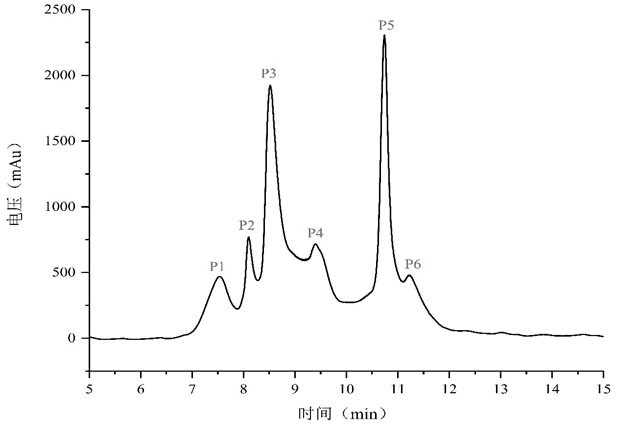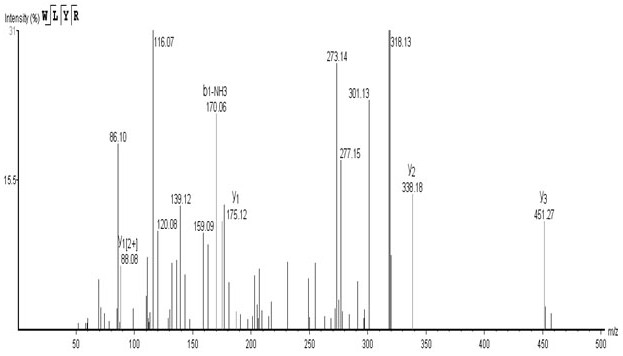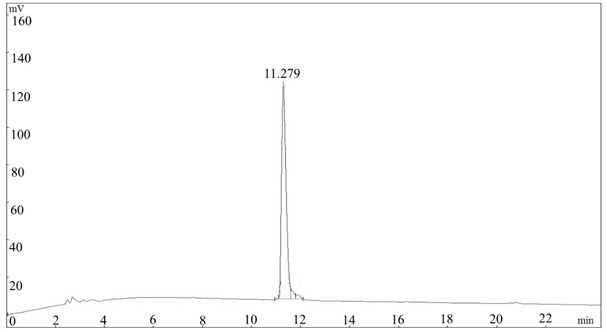Sesame-sourced low-bitterness ACE inhibitory peptide as well as preparation method and application thereof
A technology for inhibiting peptides and low bitterness, applied in the field of deep processing of agricultural and sideline products, can solve problems such as severe bitterness, and achieve the effects of easy digestion and absorption, promoting sustainable development, and small molecular weight
- Summary
- Abstract
- Description
- Claims
- Application Information
AI Technical Summary
Problems solved by technology
Method used
Image
Examples
Embodiment 1
[0034] A method for preparing low-bitter ACE inhibitory peptides from defatted sesame powder, which specifically includes the following steps:
[0035] 1) Preparation of defatted sesame powder:
[0036] The sesame cake was crushed and degreased using a Soxhlet extractor. The solvent was petroleum ether (boiling point 40-60°C), the extraction temperature was 60°C, and the degreasing was performed for 7 h. Grind the defatted sesame meal raw material, pass through a 100-mesh sieve, and collect the under-sieve, which is defatted sesame powder. The protein content determined by Kjeldahl method (GB5009.5-2003) is 51.23%;
[0037] 2) Proteolysis:
[0038] The defatted sesame powder obtained in step 1) is added with distilled water according to the material-to-liquid ratio of 10 g: 100 mL and stirred evenly. Use 6 mol / L NaOH to adjust the pH to 8.2, then add 9000 U / g at 50-55°C 原料蛋白 Add 4000 U / g of alkaline protease Alcalase after enzymolysis at 50-55℃ for 1 h 原料蛋白 Flavor protease...
Embodiment 2
[0045] The invention discloses a method for artificially synthesizing low-bitterness sesame ACE inhibitory peptide, which is artificially synthesized by a solid-phase synthesis method. The basic process is as follows: first, an amino acid whose amino group is protected by Fmoc group is connected to the insoluble solid phase carrier Wang resin, and then the protecting group of the amino group is removed, and the first amino acid is connected to the solid phase carrier; secondly, the amino acid group is protected by Fmoc group. The carboxyl group of the second amino acid protected by the group is activated with a condensing agent, and the activated amino acid reacts with the amino group of the first amino acid that has been attached to the solid phase carrier to form a peptide bond. At this time, a Dipeptides with protective groups. Repeat the above-mentioned peptide bond formation reaction to grow the peptide chain from the C-terminus to the N-terminus until the required length...
PUM
| Property | Measurement | Unit |
|---|---|---|
| Boiling point | aaaaa | aaaaa |
Abstract
Description
Claims
Application Information
 Login to View More
Login to View More - R&D
- Intellectual Property
- Life Sciences
- Materials
- Tech Scout
- Unparalleled Data Quality
- Higher Quality Content
- 60% Fewer Hallucinations
Browse by: Latest US Patents, China's latest patents, Technical Efficacy Thesaurus, Application Domain, Technology Topic, Popular Technical Reports.
© 2025 PatSnap. All rights reserved.Legal|Privacy policy|Modern Slavery Act Transparency Statement|Sitemap|About US| Contact US: help@patsnap.com



